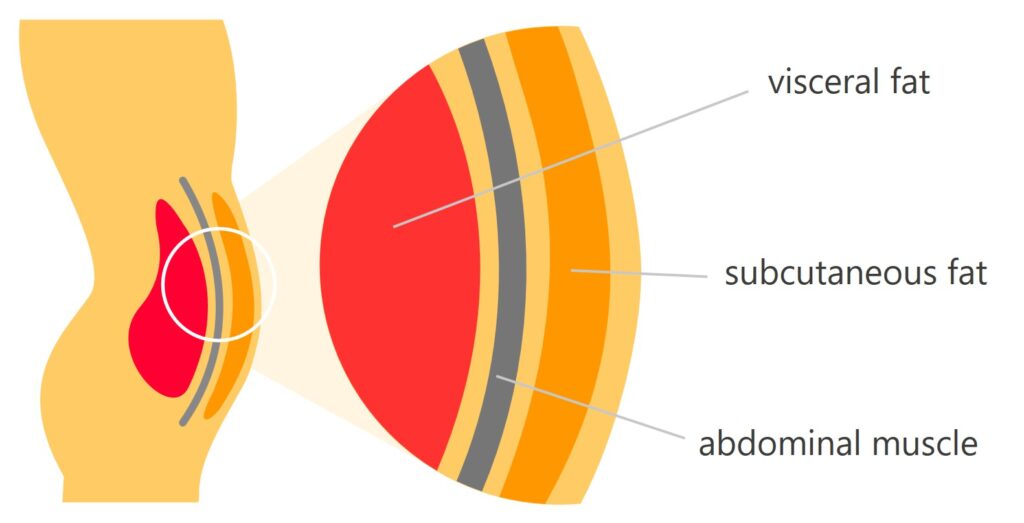Different Types of Fat
Subcutaneous fat is the visible fat one can see on their body. Think of common places one may see fat such as the abdomen, thighs, and hips; this fat can often be pinched with fingers or skin calipers. Subcutaneous fat is completely normal in every body; some may have more or less than others. This type of fat is often the type people want to lose because it is the fat that is noticeable. Subcutaneous fat is thought to be relatively harmless and also helpful. It is right under the skin and helps to cushion our organs that need protection.
The other type of fat in the body is visceral fat. This kind of fat surrounds the organs in our abdominal cavities and is more harmful to our health. Unfortunately, visceral fat cannot be seen or felt; but everyone has it regardless of body type and shape.
How does visceral fat affect me?
Visceral fat plays a key factor in disease development; it produces various hormones and proteins that can result in negative health outcomes. Visceral fat can contribute to chronic health conditions such as cardiovascular disease, Alzheimer’s Disease, and Type 2 Diabetes among many others.
Are there ways you can tell if you have excess visceral fat?
Just because visceral fat may not be visible or tangible, doesn’t mean there aren’t any ways to try and tell if you have excess. Measuring your waistline can help indicate how much visceral fat you have. To start, grab a tape measure and put it around your waistline, and then measure on the line of your belly button. For women, a waist circumference ≥ 35 inches and for men ≥ 40 inches can indicate an overabundance of visceral fat. Visceral fat can also be determined through CT and DEXA scans, along with MRIs; though these options are not easily available for everyone nor cheap. Please note that these measurement techniques are not 100% correct in detecting the exact amount of visceral fat you may have.
Are there ways that I can combat visceral fat?
Don’t fear! Just because you cannot see or feel visceral fat doesn’t mean you should panic. There are plenty of counter-strategies available to manage and decrease visceral fat in the body.
- Exercise: exercising has tons of benefits for both our mental and physical health. It is also effective in decreasing visceral fat. Cardio has been shown to decrease visceral fat levels in the body. Some great examples of cardio exercises are brisk walking, running, cycling, and swimming. It can also help to add other cardio exercises to strength-building routines such as burpees, jumping jacks, and jumping rope. High-Intensity Interval Training, HIIT, is another great form of exercise that can reduce visceral fat. Most importantly, have fun with your cardio exercises and find ways you can incorporate cardio into your daily routine. For example, choose the stairs, park further away from your destination, or dance to your favorite song! There are plenty of effective cardio exercises out there. Once you find a few you enjoy, stick to them, and keep finding new ways to be active and keep moving.
- Proper Diet: nutritional balance is also a huge key in lessening how much visceral fat you have. Limiting your intake of trans fats, fried foods, and excess sugar can help keep your visceral fat at bay.
- Lifestyle Choices: even with a balanced diet and plenty of cardio, it is crucial to factor healthy lifestyle choices into the equation for reducing visceral fat. Some lifestyle choices to keep in mind are smoking, drinking habits, and sleep. Smoking can escalate the amount of visceral fat stored in the abdomen. Also, be mindful of your alcohol intake as consistent excessive drinking can lead to fat from alcohol being stored as visceral fat. Another important factor to keep in mind is getting adequate sleep and a good night’s rest.
It is crucial to note that there is no easy solution for decreasing visceral fat. With a strong dedication to taking care of your health and patience, you can take control of your visceral fat and change it for the better. Remember you can always talk to your dietitian or exercise specialist for more information and tips to combat visceral fat.




